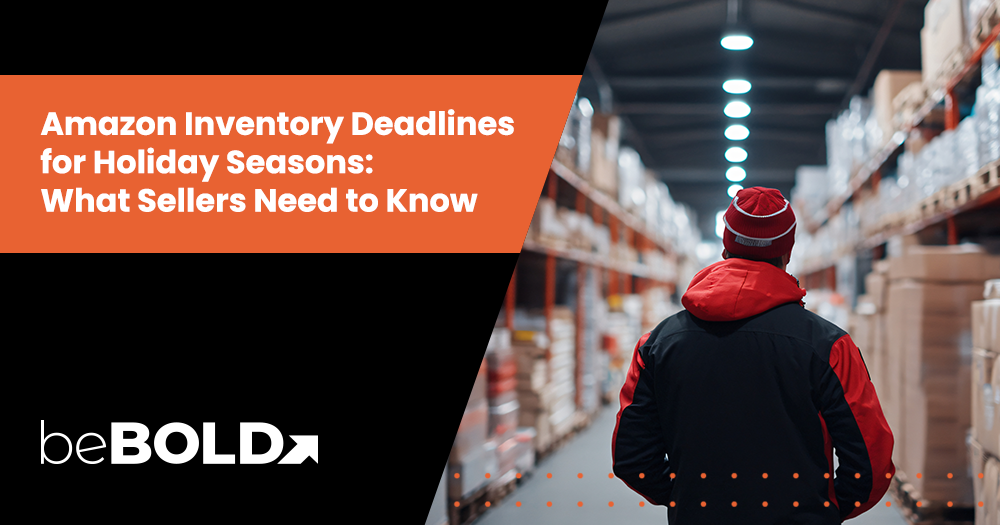The holiday season is the busiest and most competitive time for sellers on Amazon. To ensure Prime eligibility, avoid fulfillment delays, and make the most of major sales events, it's crucial to plan your inventory well in advance. Below is a quick summary of the most important deadlines to keep your brand prepared.

Source: Adobe Stock
Key Summary
- Amazon has released a tighter schedule of deadlines for deal submissions, inventory arrivals, and promotional events in Q4 2025, making advance planning more critical than ever. 📆
- Sellers aiming for Prime‑badge eligibility during Prime Big Deal Days and Black Friday/Cyber Monday must ensure their inventory is in Amazon Warehousing & Distribution (AWD) or FBA fulfillment centers well ahead of event dates. 🚚
- The peak fulfillment fees period runs from October 15, 2025 through January 14, 2026, impacting FBA, Remote Fulfillment, Multi‑Channel Fulfillment (MCF), and Buy with Prime services. 💸
- Missing these deadlines can lead to lost visibility, lower rankings, fewer sales, and reduced profit margins for brands that aren’t fully prepared. ⚠️
Amazon Timeline of Events for Q4
Here is the timeline of key deadlines for U.S. Amazon sellers in 2025. These dates aren’t just calendar markers. They directly determine how visible your products are, whether you qualify for the Prime badge, and how efficiently your fulfillment operations run. By aligning your logistics, marketing, and promotions with these deadlines, you can maximize Q4 performance while avoiding costly delays or disqualified deals.
|
Event |
Deal Submission Deadline |
Inventory Arrival Deadline (Prime‑badge eligible) |
|
Prime Big Deal Days (October) |
|
|
|
Black Friday / Cyber Monday Week |
|
|
Additional important timeline items:
- Peak fulfillment fees begin October 15, 2025 and in effect through January 14, 2026.
- Prime Exclusive Discounts (PEDs) open September 10, 2025. Coupons submit dates follow closer to events.
Risks of Missing Amazon’s Inventory Deadline

Deadlines aren’t just guidelines. They're firm cutoffs that directly impact visibility, eligibility, and sales. Falling behind can create a chain reaction that hurts both your operations and profitability. Below are the biggest risks sellers face when their inventory misses Amazon’s timeline:
Limited Receiving Capacity
Amazon Fulfillment Centers gear up well in advance. As the holiday season advances, receiving capacity becomes constrained. Late shipments may face delays in unloading, slower check‑in, and missed Prime badge status for promotions.
Lost Sales and Demand
Without Prime‑eligible status, you lose buyer trust, visibility in Amazon’s rankings, and placement in promotional slots. Late inventory can cause stockouts during high‑traffic events, meaning missed revenue opportunities.
Operational Disruption
Missing deadlines leads to rushed freight, poor packaging, or shipment rejections. Peak fulfillment fees make inefficiencies even more expensive, and late arrivals can force discounting or lost margins.
Key Terms Every Seller Must Know About Amazon Inventory Deadlines
Understanding Amazon’s holiday terminology is essential for planning effectively. These definitions provide clarity on how inventory flows, how deadlines are enforced, and what each program means for your Q4 strategy:
Amazon Warehousing and Distribution (AWD)
Amazon Warehousing and Distribution (AWD) is Amazon’s large-scale storage and replenishment program. It is designed to hold overflow inventory outside of standard FBA fulfillment centers and automatically replenish them when stock runs low. This helps sellers stage products early and maintain consistent availability.
Fulfillment by Amazon (FBA)
Fulfillment by Amazon (FBA) is the core service where Amazon manages storage, picking, packing, shipping, and returns. Sellers ship their products directly to Amazon’s fulfillment centers, and Amazon handles the rest. There are two primary shipment routing methods:
- Minimal split shipments: Shipments are sent to a limited number of fulfillment centers, making routing simpler and often cheaper. Because Amazon has less flexibility to distribute these products, the arrival deadlines are earlier to give them time to allocate stock for nationwide coverage.
- Optimized/distributed splits: Amazon divides your inventory across multiple fulfillment centers for faster nationwide delivery and better Prime coverage. This gives sellers a slightly later arrival deadline, but shipments must meet stricter requirements such as correct carton labeling and precise routing to avoid delays.
Prime Badge Eligibility
The Prime badge is a marker of fast and reliable shipping that directly impacts sales. To earn it, products must arrive by the official deadlines, meet packaging and labeling requirements, and be available in stock. Missing deadlines means losing this critical advantage in visibility and conversion — and as we've seen in our analysis of Amazon Prime Day 2023, timing and preparedness play a major role in which brands win during peak events.
Inventory Deadlines
Inventory deadlines are the firm dates by which shipments must arrive at Amazon’s facilities, not when they are shipped. These deadlines ensure stock is processed in time for major events.
Want to learn more about Amazon Inventory Management? Read about it here at Amazon Inventory Management Explained.
Black Friday and Cyber Monday
Black Friday and Cyber Monday (BFCM) represent the biggest shopping weekend of the year on Amazon. These back-to-back events occur immediately after Thanksgiving and drive the highest traffic volumes of Q4.
beBOLD’s Amazon Checklist
To help sellers stay organized and avoid costly mistakes, we’ve outlined a step‑by‑step action plan. This checklist is designed to guide you from forecasting demand to monitoring Seller Central alerts, ensuring every part of your Q4 operations is covered.
- Map SKUs & forecast demand – Go beyond a simple sales report. Review historical data, category trends, and competitor performance to identify your most profitable SKUs. Prioritize items with proven Q4 demand and ensure secondary SKUs have safety stock ready.
- Plan shipments early – Don’t just aim for the exact cutoffs; build in a 1 to 2 week margin buffer to account for transit, carrier delays, or Amazon dock congestion. Align freight schedules with AWD or FBA routing requirements.
- Submit deals & promos ahead – Mark calendars for Sept 12 (October event) and Oct 28 (BFCM). Prepare ASINs, optimized listings, and creative assets well in advance so you can submit with confidence and avoid last‑minute errors.
- Budget for peak fees – Peak fees apply Oct 15, 2025 to Jan 14, 2026. Run margin simulations including fulfillment fees, deal costs, and ad spend so you can decide which SKUs to promote heavily and which to throttle.
- Optimize packaging & labeling – Double‑check carton contents, barcodes, and prep requirements. Incorrect or non‑compliant packaging is a leading cause of delays at fulfillment centers.
- Secure carriers & appointments – Reserve freight early and account for Amazon’s 7‑day delivery windows in Send‑to‑Amazon. Work with reliable 3PL partners to avoid rejected or late appointments. For brands that rely heavily on weekend shipments or tight cutoffs, understanding carrier timelines is just as important—our guide, Does USPS Deliver on Saturday, breaks down weekend delivery expectations so you can better plan your inbound logistics and avoid fulfillment delays.
- Monitor inventory performance – Track IPI scores, sell‑through rates, and daily stock levels. Use AWD as a pressure valve to replenish FBA automatically and avoid running out of stock on high‑velocity items.
- Review Seller Central alerts – Set reminders to check your Amazon Seller Central alerts daily for changes. Amazon frequently updates deadlines, fee structures, and event guidelines during Q4, so stay proactive instead of reactive.
Don’t Miss Amazon’s Holiday Deadlines - Let beBOLD Digital help
The holiday season is make‑or‑break time for Amazon sellers. On the one hand, the right inventory planning, timely promotions, and smart margin management can skyrocket performance. But on the other hand, missing deadlines can mean lost opportunity and revenue. beBOLD Digital can help align your inventory, ads, and SEO strategies for maximum Q4 success. Schedule a quick call with us today so we can help you optimize your Amazon playbook for the busiest shopping season.
Frequently Asked Questions
Why did Amazon advance its holiday inventory deadlines?
Amazon adjusted its holiday inventory deadlines to better manage the capacity of fulfillment centers and enhance customer satisfaction. By moving the deadlines earlier, they can avoid bottlenecks and ensure products qualify for Prime badge eligibility.
What is the Christmas inventory cut‑off date for Amazon FBA?
While there isn't a single official cut-off date, December 1, 2025, is generally used as a guideline for planning. Keep in mind that earlier deadlines apply for event eligibility.
Are the deadlines the same across marketplaces (US, UK, EU)?
No. Deadlines vary by region due to local demand patterns and logistics. Be sure to check the announcements on Seller Central for specific dates related to each marketplace.
How do FBA capacity limits impact holiday inventory planning?
Capacity limits can restrict how much stock Amazon accepts. Use AWD as a buffer and monitor IPI scores to avoid restrictions.
What happens if inventory arrives at FBA after the deadline?
If inventory arrives late, it may miss out on Prime badge eligibility, lose out on promotional placement, and risk stockouts during peak events.
When do peak‑season fulfillment fees start and end in 2025?
The peak-season fulfillment fees will begin on October 15, 2025, and continue through to January 14, 2026. These fees apply across various services, including FBA, Remote Fulfillment, MCF, and Buy with Prime.










Comments